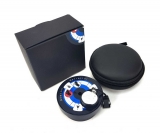- Details
- More images
Products description
TS-Optics 2" LED collimator (adjustment) for RC telescopes and all other telescope types
The R.E.E.E.G.O collimator was developed for Ritchey-Chrétien telescopes, but also for all other types of telescopes such as refractors, Newtonians or SC Cassegrains.
♦ The corrector enables accurate collimation of almost all optical systems with high accuracy.
♦ The collimator is entirely designed and manufactured in Italy.
♦ Suitable for all 2" receptacles
♦ The LEDs are powered by an integrated CR2032 battery (replaceable).
♦ We recommend the collimator above all for RC telescopes, Cassegrains and Schmidt Cassegrains, so that a first-class collimation condition of the telescope can also be produced underground
TS R.E.E.E.G.O. 2" LED collimator for all telescope types
The collimator is built in Italy. It is compatible with almost all common optical systems and allows clean collimation during the day. In particular, we recommend the collimator for all Cassegrain telescopes such as Schmidt-Cassegrain, RC, Dall-Kirkham and similar types of telescopes. The collimator is very precise and the collimation result is largely independent of tilting.
Collimation of Ritchey-Chrétien telescopes and similar systems
It is well known that collimating an RC is not a simple matter. As a rule, night-time use at the star is necessary here. Thanks to the R.E.E.E.G.O. collimator it is possible to achieve an optimal collimation result during the day, which is comparable to the Takahashi collimator. This means that you always have an optimally adjusted RC telescope at your disposal during the night. The collimation is simple and can be carried out by anyone. But it is important that the secondary mirror of your telescope has a central marking. Just do the following:
The preparation:
Place the optical tube on a table or level the telescope on your mount. It is helpful to align the telescope to a homogeneous, bright surface (paper, house wall...). Now insert the collimator into the 2" receptacle of your focuser. It helps if you align the labeling with the collimation screws, this makes work easier. Press the collimator slightly with your hand from behind. This ensures that the collimator sits optimally in the extension. Now tighten the clamping screws slightly. Now switch on the collimator in Newtonian/reflector mode (red LEDs). Now look through the hole.
If the image looks like this, you can cancel the collimation process, your telescope is optimally adjusted and ready for the night.
However, if the image does not look centric, you should start collimating to get the best result from the telescope.
Step 1 - Adjustment of the secondary mirror:
Adjust the secondary mirror with the adjusting screws until you have the central marking of your secondary mirror exactly in the middle. You will immediately see the smallest deviations, which you can easily adjust. Please ensure that the lock screws are loosened beforehand (if available) and that the secondary mirror is not loose after collimation.
At the end of this collimation step, the result should look like this.
Step 2 - Adjusting the primary mirror:
Now center the outer ring by adjusting the primary mirror. Please make sure that the lock screws are loosened beforehand. Loosen the lock screws only slightly, then adjust the primary mirror and then tighten the lock screws slightly. This procedure prevents the cell from being over-stressed or from becoming completely loose. Also, do not overtighten the lock screws.
At the end of the collimation the result should look like this. Collimation is complete and your telescope is ready for the night.
RC telescopes with TILTING mechanism on the focuser:
Many Ritchey-Chrétien telescopes have a third collimation option, tilting the focuser (tilting). Attempts have often been made to compensate for poor collimation with this tilting, which does not work well. Therefore you should set the tilting mechanism to the stop before collimation. This ensures that the optics are optimally adjusted to the focuser.
You should use the tilting mechanism to optimally adjust the camera sensor to the telescope. This allows you to compensate for a slight misalignment of the sensor or a slight tilting of the focuser.
Type:Collimator
Telescope-side connection: 2" receptacle
The R.E.E.E.G.O collimator was developed for Ritchey-Chrétien telescopes, but also for all other types of telescopes such as refractors, Newtonians or SC Cassegrains.
♦ The corrector enables accurate collimation of almost all optical systems with high accuracy.
♦ The collimator is entirely designed and manufactured in Italy.
♦ Suitable for all 2" receptacles
♦ The LEDs are powered by an integrated CR2032 battery (replaceable).
♦ We recommend the collimator above all for RC telescopes, Cassegrains and Schmidt Cassegrains, so that a first-class collimation condition of the telescope can also be produced underground
TS R.E.E.E.G.O. 2" LED collimator for all telescope types
The collimator is built in Italy. It is compatible with almost all common optical systems and allows clean collimation during the day. In particular, we recommend the collimator for all Cassegrain telescopes such as Schmidt-Cassegrain, RC, Dall-Kirkham and similar types of telescopes. The collimator is very precise and the collimation result is largely independent of tilting.
Collimation of Ritchey-Chrétien telescopes and similar systems
It is well known that collimating an RC is not a simple matter. As a rule, night-time use at the star is necessary here. Thanks to the R.E.E.E.G.O. collimator it is possible to achieve an optimal collimation result during the day, which is comparable to the Takahashi collimator. This means that you always have an optimally adjusted RC telescope at your disposal during the night. The collimation is simple and can be carried out by anyone. But it is important that the secondary mirror of your telescope has a central marking. Just do the following:
The preparation:
Place the optical tube on a table or level the telescope on your mount. It is helpful to align the telescope to a homogeneous, bright surface (paper, house wall...). Now insert the collimator into the 2" receptacle of your focuser. It helps if you align the labeling with the collimation screws, this makes work easier. Press the collimator slightly with your hand from behind. This ensures that the collimator sits optimally in the extension. Now tighten the clamping screws slightly. Now switch on the collimator in Newtonian/reflector mode (red LEDs). Now look through the hole.
If the image looks like this, you can cancel the collimation process, your telescope is optimally adjusted and ready for the night.
However, if the image does not look centric, you should start collimating to get the best result from the telescope.
Step 1 - Adjustment of the secondary mirror:
Adjust the secondary mirror with the adjusting screws until you have the central marking of your secondary mirror exactly in the middle. You will immediately see the smallest deviations, which you can easily adjust. Please ensure that the lock screws are loosened beforehand (if available) and that the secondary mirror is not loose after collimation.
At the end of this collimation step, the result should look like this.
Step 2 - Adjusting the primary mirror:
Now center the outer ring by adjusting the primary mirror. Please make sure that the lock screws are loosened beforehand. Loosen the lock screws only slightly, then adjust the primary mirror and then tighten the lock screws slightly. This procedure prevents the cell from being over-stressed or from becoming completely loose. Also, do not overtighten the lock screws.
At the end of the collimation the result should look like this. Collimation is complete and your telescope is ready for the night.
RC telescopes with TILTING mechanism on the focuser:
Many Ritchey-Chrétien telescopes have a third collimation option, tilting the focuser (tilting). Attempts have often been made to compensate for poor collimation with this tilting, which does not work well. Therefore you should set the tilting mechanism to the stop before collimation. This ensures that the optics are optimally adjusted to the focuser.
You should use the tilting mechanism to optimally adjust the camera sensor to the telescope. This allows you to compensate for a slight misalignment of the sensor or a slight tilting of the focuser.
Type:Collimator
Telescope-side connection: 2" receptacle
Categories
Quick purchase
Welcome back!
Manufacturer


